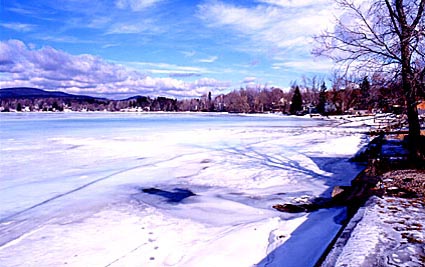|

The Connecticut River in winter.
Winter fishing.
Covered bridge.The Connecticut River is a major river in New England. The river is some 650 kilometres (400 miles) long, and has a drainage basin covering 29,000 square kilometres (11,300 square miles). The source of the Connecticut River is at Fourth Connecticut Lake in northern New Hampshire close to the Canadian border. The Connecticut forms the boundary between the states of New Hampshire and Vermont, and flows through both Massachusetts and Connecticut. Its mouth is on the Atlantic Ocean in Connecticut at Old Saybrook on the shores of Long Island Sound. The name Connecticut comes from the native American Quenticut or Quinatuquet, meaning long tidal river. In its upper and lower course, the river cuts into ancient rocks that represent the remains of old mountain systems. In the middle course it flows over a series of shale and sandstone rocks and here the valley is wider. The whole valley contains a covering of glacial deposits. The Connecticut River watershed is still two thirds forested. On July 30, 1998, President Clinton designated the Connecticut an American Heritage River. The watershed includes parts of two National Forests (White Mountain and Green Mountain). For the last 100 kilometres (60 miles) the river is tidal and boats with a 5 m (15 feet) draft can reach Hartford, Connecticut. The river is liable to flooding both from winter storms and from snowmelt. To try to combat this a number of flood control dams have been built on the upper reaches of the river. The navigable depth of the river has meant that it has a long history as a major artery of navigation. The upper river includes many rapids and waterfalls and the steep course has been harnessed for hydroelectric power. The first European to travel along the Connecticut River was Adrian Block in 1614. The settlement of the valley was by English colonists who came from Massachusetts to settle near Hartford in 1630. The river provides the focus for transport and for industry from two centuries and many towns grew up along its banks. It was an important place for the early development of the Industrial Revolution in America. Its greatest importance was in the early days of colonization, and by the mid 19th century the river was in decline as the importance of the railroad took over. With its decline in importance, the river became very neglected and was heavily polluted. It was often termed America's best landscaped sewer. The result of this unattractive feature was that the river was even more ignored and neglected. It took the Federal Clean Water Act of 1972 to begin to turn things around. The result has been a great improvement in water quality and the return of many important indicators of good water quality, such as the salmon. As people increasingly seek recreational space the advantages of the Connecticut river so close to major centers of population, has caused many people to look again at this river and begin to develop it and improve the quality of the environment. The entire Connecticut River watershed has been designated a National Fish and Wildlife Refuge. The river's tidal wetlands have also been designated as of international importance |